Dying Light: A Guide to the Elven Realm
The Fourth Age is the age of Men. Those Elves yet in Middle-earth heed the call of the Sea and depart for the West, or choose to remain in a world that will see them fade into memory and then fairy tale.
But, though their numbers steadily dwindle, the remaining Elves may yet play a part in the great events of the Age.
The portrayal of the Elves in Fourth Age: Total War – The Dominion of Men is one of the most convincing and compelling aspects of the mod. While leading the Elven faction, you’re tasked with preserving the fading and fractured realms of the Firstborn in an age that has given rise to the Empire of Harad, the Shadow Cult, civil war among the Dunedain, and the encroachment of Men into almost every corner of Middle-earth – all while the power of the Eldar is irresistibly vanishing from the world.
Given their unique situation, the Elven faction plays very differently from the others. Some quick reference points:
-Elven troops can only be trained in your Homelands: your starting settlements, plus Rivendell.
-These Homelands suffer from low population growth. Some Homeland settlements will never see positive growth. As a result, Elven troops, though extremely powerful, will be rare.
-Your Homelands may be ‘converted’ to a Mannish population. This is done by constructing the regional building available in these settlements (for example, ‘Lindon’ in Forlond, or ‘Western Wilderland’ in Caras Galadhon). As the building description indicates, this construction represents the settling of Men in the province: it will permanently prevent you from training any Elves there, but will allow the recruitment of Elvellyn – Mannish ‘Elf-friends’ – and improve population growth.
-Outside your Homelands, you’ll only be able to train Elvellyn. Though weaker than Elven troops, they are necessary because there simply aren’t enough Elven warriors to expand and hold new territories.
-Unlike the Dwarves (whose ‘native’ units are similarly restricted to Homelands, and who can train Mannish troops elsewhere), your Mannish support soldiers do not see a great deal of variety from region to region. That is, you’ll have roughly the same Elvellyn roster in Eriador as you would in Khand. The exceptions are your Fiefdoms – Lune, Feorfeld, and Langwyke, discussed in more detail below – where you can train your high-tier, well armored Elvellyn Guard. Also, in provinces with the ‘Horses’ resource, you will be able to construct a Specialization Building that allows recruitment of Elvellyn riders – your only (non-mercenary) Mannish cavalry.
-Building options are different for the Elves: Specialization Buildings may only be built in Mannish provinces, but the Elves do not need to commit any settlement to a particular Policy (Military, Financial, or other).
-Ost-in-Edhil, in addition to being one of your campaign objectives, is special. It is a ‘permanent fort’ at game start, offering no recruitment or construction options (but allowing for retraining of local mercenaries and giving a nice trade boost). But, when governed by an Intelligent and Charismatic Elf of Sindar or Noldor lineage who has the True-seer or Foresight trait, it can be converted to a proper settlement, complete with all the building and (Mannish) training you’d expect. Setting Ost-in-Edhil apart from other settlements, though, is the fact that it is the only place where you can exploit mithril for profit and armor improvements. So watch for adoption candidates with the right mix of traits, and don’t leave Ost-in-Edhil for your final conquest if you want to get the best advantage from owning it.
With those points in mind, we’ll examine the Elven Realm as it exists in the early Fourth Age.
All Elvendom is divided into three parts –
… err, sorry. Channeling my Caesar there.
But broadly speaking, the Elven Realm does consist of three distinct regions. In the west, Mithlond, Forlond, and Harlond comprise what I’ll call the 'Lindons'. 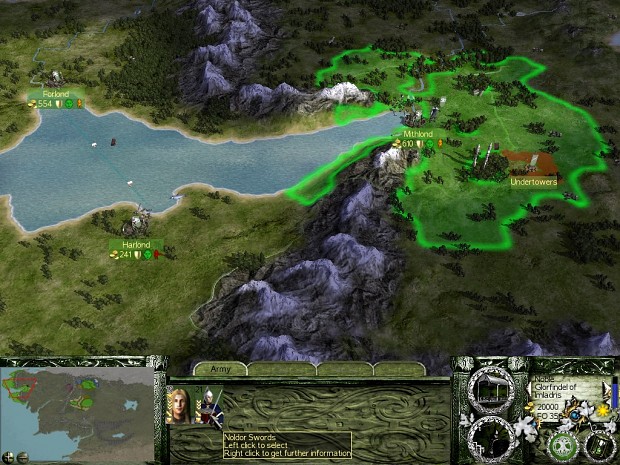
This area is characterized by the lowest overall population growth. Of the three settlements here, only Mithlond will see any growth at all, while Forlond and Harlond will at best hold steady. Given their low starting population, you won’t be able to train many troops in these latter settlements unless you convert their population to Mannish. Or, you could embrace the theme of Elven departure from this region and increase the taxes to Very High; since the population will never dip below 400, this will increase your income with essentially no impact on (your lack of) recruitment capability. Watch out for dips in your king’s Authority ranking, however, as well as displeasure on the part of lords of provinces with such high tax rates.
Mithlond is a different case. It’s worth growing the population here – and keeping it Elven - to allow training of some excellent units, such as hardy Mariner swordsmen and elite Lindon Guards. Elven Riders – a rare melee cavalry unit for you – are also available here, along with standard units such as Elven Bows and the ubiquitous Threshold Troops.
The Lindons are a fairly safe region. Neighbors include the passive Dwarves and Hobbits of the Shire, both of whom make good trade partners. To the northeast is the only bordering province owned by the Reunited Kingdom, your ally at game start. Nearby independent (rebel) settlements are also initially neutral, but you’ll want to bring them into the fold – notably Lune, north of Mithlond. Lune is one of three settlements that count as Fiefdoms for the Elves (the other two are Feorfeld, southeast of Lorien, and Langwyke, west of Amon Lanc), which allow for improved Elvellyn recruitment.
Near Mithlond waits Glorfindel. Yes, that Glorfindel. He commands a unique unit of Noldor Riders – the finest cavalry to be found anywhere in Middle-earth. These riders cannot be retrained, and when Glorfindel passes into the West – whether by being killed in battle or 'growing weary of life' – he takes his Riders with him. He is also accompanied by a separate unit of Noldor Swords. These infantry troops are similarly strong, but more long-lived than their cavalry counterparts. Since they are not tied to a captain, they will remain on this side of the Sea as long as their unit is not utterly destroyed in battle or siege, and they may be retrained in Imladris, provided you recapture it and rebuild Elrond's Library.
I can’t overstate the strength of a Glorfindel-led army, even a very small one. Those two Noldor units can take on incredible odds; add a few starting Mithlond unit such as Elven Bows, Lindon Guards, and Mariners, rally some Mannish mercenaries in the field, and you’ll have a tiny army capable of destroying just about anything in its path. Since Glorfindel’s time is limited, you’ll want to use him well.
Two of your campaign objectives are within reach - at least in theory - before Glorfindel passes: Imladris and Ost-in-Edhil. You’ll need to fight or maneuver your way past some strong Adunabar forces to reach them, but Glorfindel and co. are more than capable of this task. Head either north or south of the Shire (avoid marching on territory belonging to factions you don’t want war with, since even with an alliance and military access agreement you may find the AI rather jumpy), and then due east. Your starting scout outside Imladris can alert you to the big armies in the way, and make capturing places like Lastbridge (which guards the only handy crossing to Rivendell) easier.
Another approach is to use diplomacy. Adunabar ends up at war with lots of factions, and doesn’t border you initially. They’ll likely approach you for a ceasefire offer; counter-offer with a demand for the peaceable return of Imladris, and you can take the settlement without a fight. Of course, peace with the Cultists isn’t going to last. They command a large advantage in the North, and will soon overwhelm the Reunited Kingdom’s presence here without your intervention. But taking Imladris with a stroke of the pen allows you to keep Glorfindel’s forces in the field, consolidating your gains in other areas.
The second distinct region of the Elven Realm consists of two settlements: Caras Galadhon and Amon Lanc (Lorien and East Lorien). These settlements are sundered by the Anduin, with the closest crossing at the Undeeps, just south of Feorfeld. 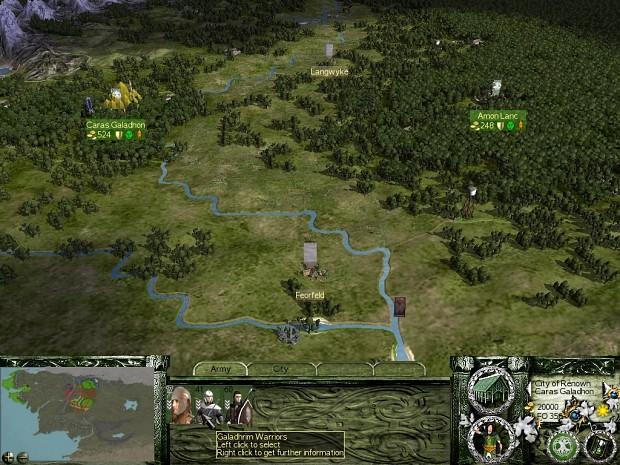
Elven troops available here tend to be defensive in nature: the Galadhrim Scouts and Galadhrim Warriors are skilled with bow and sword, making stronger 'hybrid' soldiers than the more readily available Greenwood troops to the north. But the 'Loriens' are, like the Lindons, stunted in terms of population growth. You may as well train a unit of Galadhrim Warriors early on in Caras Galadhon, but further training will have to wait until you increase population, which is quite a ways off. Amon Lanc fares a little better, but it will be many years before the infrastructure allows you to train top-quality troops.
More than any other region, then, the Loriens require support from the Elvellyn. It’s therefore fortunate that two nearby Fiefdoms will allow you to train effective Mannish troops. Feorfeld is the closest candidate, just a couple of turns south of Caras Galadhon. It’s an easy early capture for your family member and the few other Elven units you can bring along. Feorfeld only borders Rohan to the south, making it a safe place to develop for a few decades – provided you can stay in Rohan’s good graces and keep Adunabar from expanding west over the Great River.
Langwyke, the other independent Fiefdom, is west of Amon Lanc. You definitely want this settlement eventually, but taking it too soon may invite an early war with the Beornings, who are looking to extend their sway southward along the Anduin.
Still, Beorn’s descendants and their Woodmen allies are not a serious threat – most of the time. Your Elven soldiers can hold off wave after wave of their poorly armed spear- and axemen. But beware the family members: the Beorning Guard are massive warriors wielding great axes that can make short work of your lower-tier troops.
War with the Beornings is probably inevitable. Winning the war will give you your only opportunity to link up all (or most) of your territories, from the Loriens up the Anduin to the northern Greenwood, west over the High Pass to Imladris and across Arnor to the Lindons. If you manage to secure passage around Oldford and the High Pass, you’ll be able to assemble an army boasting troops from all over the Realm.
Other opportunities near Lorien include the independent Mid-deeping, the settlement in the Brown Lands to the south of Amon Lanc. The Brown Lands often become a battleground between several factions; Adunabar, Rhovanion, and eventually Dale, Rohan, the Beornings and even Rhun may all try to secure it for themselves. Denying Adunabar this settlement may stifle their ambitions in the south and keep Rohan safe. But it’s a risky move. Taking Mid-deeping requires an investment of military power that may leave your other nearby settlements vulnerable to Beorning attack. It will certainly be a hotly contested settlement, and may involve you in wars you don’t want. Your consolation is that, by projecting Elven power into the south, you can influence events in the region and avoid making the eaves of the Greenwood and Lorien itself the front lines in a war against a strong foe.
The third and final region of Elven Lands – the northern Greenwood - consists of two settlements: the Elvenking’s Halls in the northeast, and Emyn-duir just north of the forest’s central mountains. These settlements boast the highest population growth and the readiest recruitment potential of anywhere in the Realm, as most of the remaining Elves in Middle-earth gather here to withdraw from the outside world.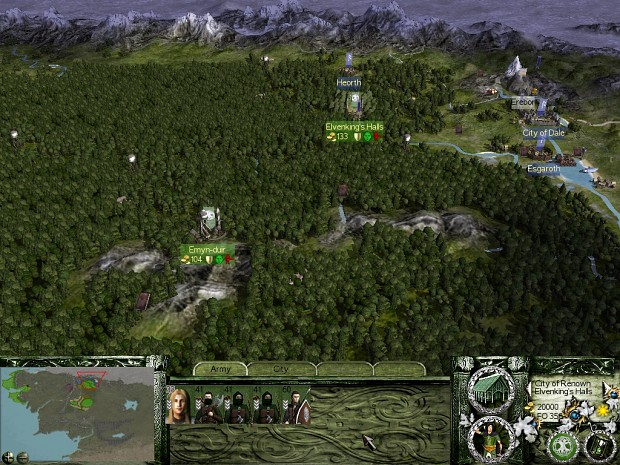
The Elvenking’s Halls is the initial capital of the Elven Realm (but as you expand you’ll want to consider setting a new capital to ensure public order in newly conquered settlements). Here also is gathered a substantial part of your armed forces. Unfortunately, soldiers here are not doing you much good, at least in the early years. The northern Greenwood is fairly isolated from attack, and your nearest neighbors – the Men of Dale – are busy fighting Easterlings and exerting hegemony over their Northmen rivals. But getting your troops to where they are most needed – say, the southern Greenwood - requires marching them for several turns over territory that you may not have military access to.
I tend to leave them in place until nearby threats present themselves - when the Beorning war erupts, for example. Or, if (when) Dale makes trouble, they can be well-positioned to seize chokepoints along the northern borders, such as Heorth or Framsburg. It’s also good to have this reserve force available in case enemy factions send armies through the Greenwood trails, near your heartland.
Greenwood’s warriors tend toward stealthy archery tactics. Apart from the standard Threshold Troops and Elven Swords, every unit trainable in these provinces carries a bow. Greenwood Bows are archers with some melee capability, while the Greenwood Guard carry a great axe in addition to their bows, making them dangerous flankers. Elven Scouts – available here and in the Loriens – are the only horse-archer unit you can train. While few in numbers, this unit adds some very welcome mobility to forces east of the Misty Mountains.
Most of your battles will play out as an epic last stand against innumerable hordes. This is because you hardly ever have more than a few Elven units in the same army – but those Elves can, more often than not, handle 10-to-1 odds with aplomb. Even the basic, tier-1 Threshold Troops are superior to many Mannish warriors. AI factions will throw plenty of bodies at you, but your excellent soldiers can withstand such battering and hold the field with few losses of their own.
By far your strongest units are your family members, who command units of Elven Retainers. (Glorfindel, with his unique unit of Noldor Riders, is the sole exception.) Elven Retainers are the anchor, the keystone, the foundation – whatever metaphor you want to use – for your battle line. For some of your battles, they will be your battle line, perhaps backed up by a few units of archers, skirmishers, or flankers. You can count on them to take on incredible odds in most any situation.
Your other Elven troops are great, too, but make no mistake: Elven Retainers, with their head-and-shoulders-above-the-rest stats and ability to automatically replenish losses after each battle, are the reason you can compete with rivals who can out-spend and out-train you throughout the campaign.
Given their importance, you’ll want to survey your realm at the beginning and determine where you want to fight – i.e., what cities you want to take, and where you expect you’ll need to defend. Then, get an FM there, along with at least one other unit of Elven troops. Plan to fight your way toward Mordor? Send your FM and Threshold Troops from Amon Lanc down into the Brown Lands (while training another unit of Threshold Troops for garrison duty). Want to take the fight to the Beornings early? Send your king and any troops you can spare from the capital. It's rare that you'll want to leave family members governing tiny settlements far from danger, such as Forlond and Harlond. Instead, bring them toward the front, where they can use their leadership skills to govern crucial newly captured cities - and defend such cities in case of attack.
All tiers of Elven soldiers are superb, so questions like ‘What is the ideal 20-unit Elven army?’ are essentially academic. But there are some points to keep in mind.
-Missile fire – especially javelins – can be dangerous. While your Elven archers will win most archery duels, they may take losses. I consider it a good battle when I can count on one hand the casualties my Elves have suffered, but I still hate taking any losses, because retraining is so difficult. You want your troops to last as long as possible, so make enemy ranged units a top priority and concentrate fire on them before they can return shots or charge them with melee troops (or your own archers, who are usually faster and much stronger in melee than their counterparts from other nations).
-As a corollary to the above, friendly fire can kill more of your own troops than the enemy does. Once you begin training Elvellyn, be wary of the Elvellyn Hunters (javelin-armed skirmishers): a few badly-placed volleys can thin out some of your strongest units.
-The powerful charges available to many spear-armed riders can be deadly. Target cavalry with your archers, or counter them with your spear troops: Elven Retainers, Lindon Guards, or Threshold Troops.
-Beware of armor-destroying weapons like two-handed axes. The Beorning Guard and Beorning Axes, Dale’s Hearth-troops, North Rhun’s Great Axes – troops like these can damage even superior Elven defenses and make short work of your lower-tier soldiers. In most battles, you can counter such units with arrow fire or flanking … but if you’ve left some of your homelands garrisoned by a single unit of Threshold Troops, know that such settlements are vulnerable, and keep careful watch for surprise attack.
-Trust in your cavalry. You only get a few such units – Glorfindel’s Noldor Riders, Imladris Lancers, Elven Riders, and Elven Scouts – but the melee types (especially the first two listed) are force multipliers, able to scatter many times their number of foes with repeated charges. Even the Elven Scouts can give a good showing with a well-timed charge aimed at a tired enemy unit.
-Protect your Mannish troops. In the early years, mercenaries will play an important role as garrison troops and support for your Elven warriors. In the northwest, for example, mercenary Eriador archers can serve to protect recently conquered settlements while Glorfindel and his powerful Elven soldiers keep campaigning. Later, Elvellyn will garrison settlements in the Anduin region and swell your armies in the field. But your Mannish troops can’t play either role if they get shot up by enemy archers or cut down in melee. When possible, use your Elven troops to do the main fighting, while Mannish recruits act as a reserve or flanking force.
Thanks to Elven versatility, your armies can cover all major roles. Elven Retainers, Threshold Troops, Elven Swords, Mariners, and Lindon Guards can hold the line. Melee cavalry (and to a lesser extent, attack-oriented troops like Greenwood Guards) can serve as a ‘hammer’. Your many archers can, of course, shoot, but they also make excellent flankers.
Elvellyn troops mirror this versatility, allowing you to fit them in rather seamlessly with your Elven lineup. Remember, though, that even the strongest Elvellyn do not have the benefit of centuries of training and experience. While necessary and useful in their own right, they do not have the durability of Elven units.
First-tier Elvellyn consist of Elvellyn Watch and Elvellyn Hunters. The former are standard militia-style spearmen; the latter are skirmishers, throwing javelins. I tend to use the Watch for simple garrison duty, particularly in places such as Forlond and Harlond, which are safe enough not to require a stronger (and more expensive) Elven presence. The Hunters are the unit of choice when battle is expected. Missile units are almost always good choices, and these soldiers are also capable enough against light cavalry threats, or for flanking duty when no other options are available.
Elvellyn Wardens and Foresters are available at higher tiers. Wardens are a stand-in for Elven Swords, while Foresters are ‘rangers lite’, with some ability at stealth, archery, and melee. They are the only bow-armed Elvellyn unit, so it’s likely they will function essentially as pure archers in your armies; if they are the only archers you have, you won’t want to risk them in most fights, and if you have Elven archers available, you’d rather use the latter for flanking. Still, note that their defense is better than you might expect, so don’t treat them like glass.
Elvellyn Guards are only available in your Fiefdoms (Lune, Feorfeld, and Langwyke) or converted Homelands, at the highest tier of military development. They are also the only mail-clad Elvellyn you can train, giving them some staying power in battle. As spearmen, they can be counted upon to hold a line.
Finally, in provinces with the Horse resource, you can train Elvellyn Riders after building an Elvellyn Horsemasters Specialization Building.
Early in the campaign, your forces will be small in numbers and mostly Elven, apart from the odd mercenary or Elvellyn unit. But as the campaign progresses, wars will increasingly demand a mixed force, especially in the southern parts of the realm (the Loriens), where population growth in the Elven homelands is mostly flat.
My preference is to use my Elven troops for melee whenever possible, and to use the more vulnerable Elvellyn as missile troops – Elvellyn Hunters and Elvellyn Foresters. Wardens and Guards take up a position behind or on the flanks of any Elven infantry. But note that, due to the fact that you’ll often be vastly outnumbered, flanking options are relatively rare. Even your archers will need to fight toe-to-toe.
This is why having 1 or 2 melee cavalry units can be so decisive. Glorfindel’s Noldor Riders or the Imladris Lancers are battle-winners whose repeated charges into engaged foes will mean less heavy lifting for your infantry. While Elven Retainers are excellent fighters, they can’t single-handedly shield your other troops – and the more Elven Bows or Elvellyn that get ground down in melee, the fewer soldiers you have to continue your campaign into enemy territory or hold contested settlements.
The following battle illustrates the straightforward nature of Elven tactics. 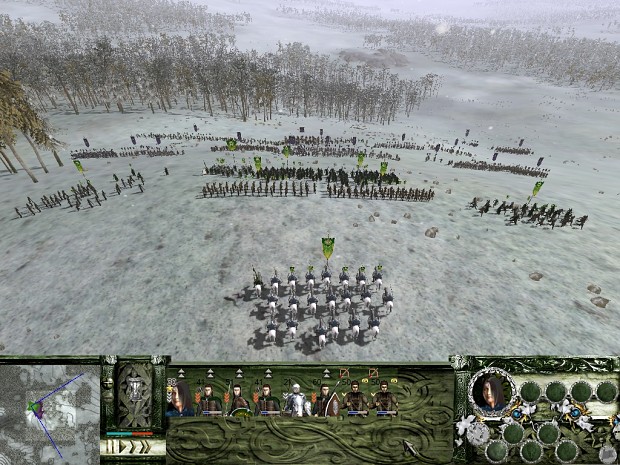
The battle takes place west of Rivendell, in Adunabar's territory. A much larger enemy host has attacked, but my Elven force has two excellent units - the family member's Elven Retainers and a unit of Imladris Lancers - as well as the terrain advantage. I keep my Lancers back to wait for a good opening, and let the enemy approach while my archers shoot them down. Note my FM deployed on the front lines. 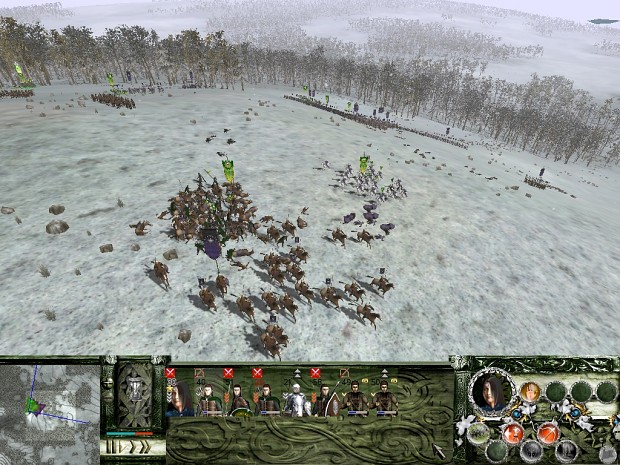
Enemy horsemen have caught my Elven Bows, but the latter are able to withstand the attack and send them running. The main infantry lines meet, and on the far flank my archers are able to outrun the enemy infantry, turning to fire when they give up the chase. 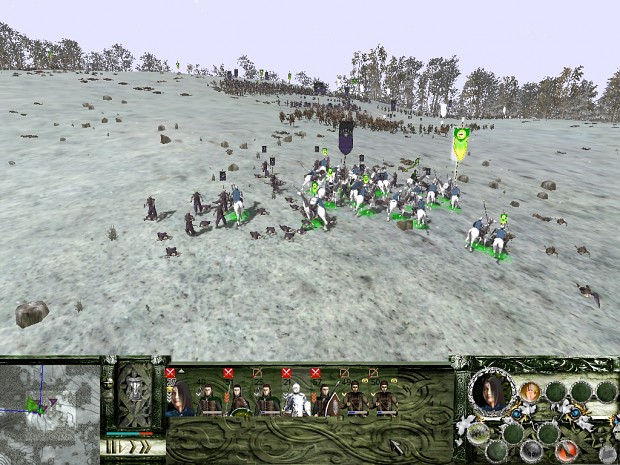
My Imladris Lancers drive into the enemy archers and scatter them, along with the approaching enemy captain. Further uphill, units on the flanks and center begin to rout. Shortly thereafter, the rest of the army follows suit. 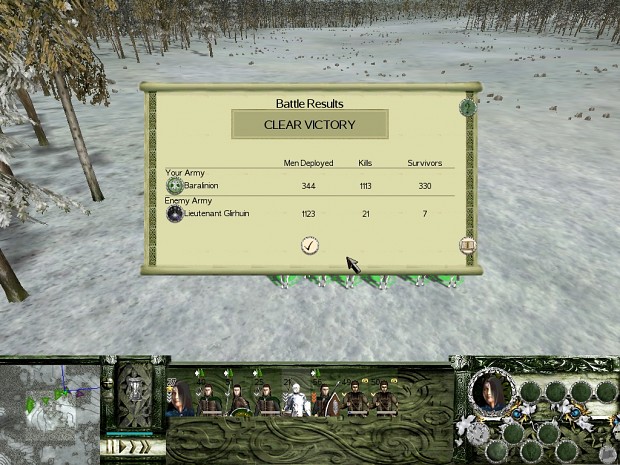
The aftermath: 14 losses, over a thousand kills. This victory opens the way to take Lastbridge.
The Elven campaign has 3 basic goals: secure Mannish Fiefdoms (Lune, Feorfeld, Langwyke); reclaim Rivendell and Ost-in-Edhil; expand elsewhere with an aim of protecting your conquests and beating back threats.
Because of the sheer distance between Elven settlements and the strength of your units, there is a lot of room for different approaches to achieving these objectives.
The first goal is within easy reach at the campaign start. All 3 Fiefdoms abut your starting territories, and can be seized within a few turns. Growing these Mannish provinces will not only allow you to develop more substantial armies; they will also become a good source of income.
You can also work toward the second goal from the first turn. Glorfindel and the Noldor Swords can be combined with a few other Elven units near Mithlond and travel toward Rivendell. Lastbridge is a necessary conquest along the way, since it bars the route east; denying this important settlement from Adunabar is a nice bonus.
Sending the Noldor Swords toward Rivendell allows them to be retrained there once military development has been undertaken in the province; and Rivendell offers an easy route south toward Ost-in-Edhil. (This route passes through Western Hollin – territory that is initially independent but may be held by Tharbad at this point. Either move quickly to take the province for yourself first, or risk offending Tharbad by trespassing.)
Rivendell is a great prize for the excellent troops that can be produced there, but also because it is an Elven outpost midway between your far-flung holdings. Once the High Pass Stronghold is secured (and the Beornings are pacified or eliminated), only Lindon is not contiguous with the rest of the Realm.
Ost-in-Edhil is an outlier - located centrally, but still somehow not quite within your reach unless you make it an early priority. Tharbad will take it if you leave it for too long. If you wish to preserve peace and still meet your campaign goals, you can purchase the settlement from them or ask for it as part of an alliance agreement. They’ll often be quite open to such overtures – not surprising, since for Tharbad Ost-in-Edhil is simply an out-of-the-way pile of rubble offering some basic fortification but little other benefit.
Before long, the inconstancy of Men will allow you to pursue your final goal of expanding your rule to 25 settlements. The Beornings are often the first neighbors to attack, and Dale will follow closely thereafter. Of the two factions, Dale is the greater danger, thanks to their large and varied armies consisting of all the troop types you prefer to avoid: long-range bowmen, heavily armed spear-throwers, powerful riders, and dangerous axemen. But both factions are close enough to your recruiting centers that pushing them back can be a matter of a few sieges. Capture important cities like Oldford, Dale, and Esgaroth, and you will have seriously damaged your foes' capacity to recruit. To end the threat without eliminating a large faction like Dale, consider gifting settlements to other factions to create a buffer between you. The Dwarves make fine stewards of the City of Dale, for example - and you can benefit from the trade they bring.
The remaining balance of settlements required for victory can be had in the northwest. If you let Adunabar run rampant through Eriador and eliminate the Reunited Kingdom's presence here, you'll need to push them back in order to avoid being driven into the Sea. The ancient cities of Annuminas and Fornost are well worth taking, and their walls make them easy to hold against Adunabar's greater numbers. With Imladris Lancers and a fair amount of archers in your armies, you will be able to crush the Cult and claim your victory.
The Elven Realm faces many dangers in the Fourth Age. But with a strong tradition and the aid of faithful Elvellyn, it can hold off the darkness and, for a time, reclaim some of the ancient glories of the kingdoms of the Eldar.
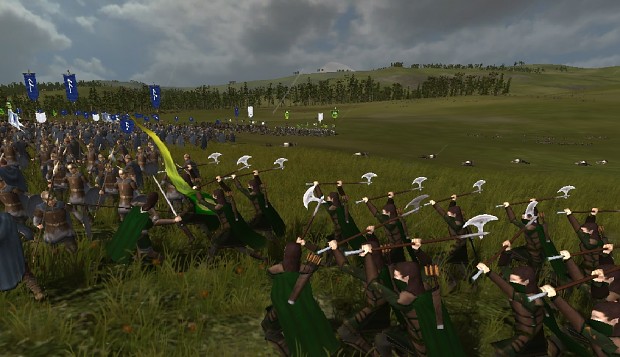
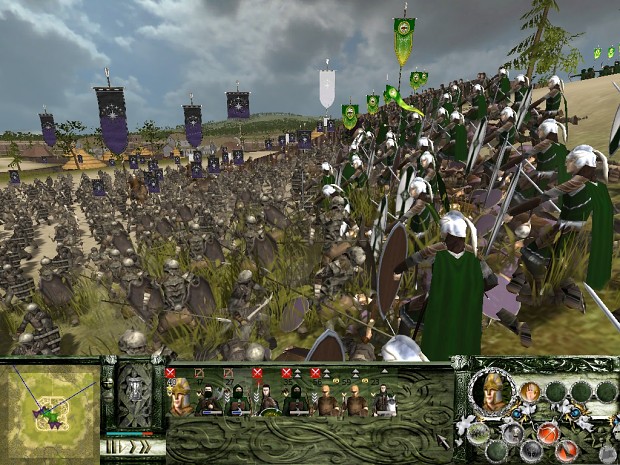
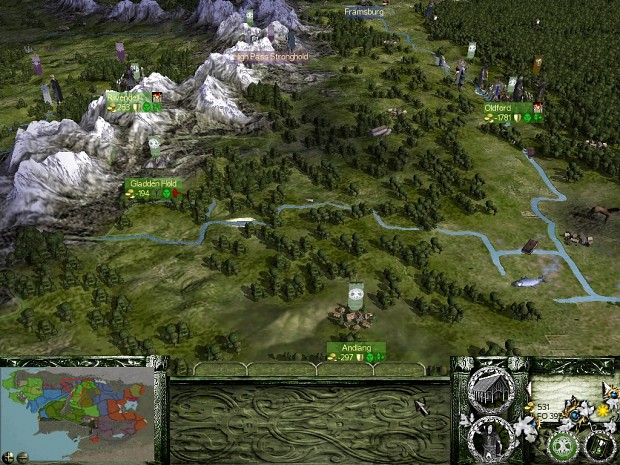




Awesome update for my favorite faction.